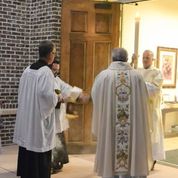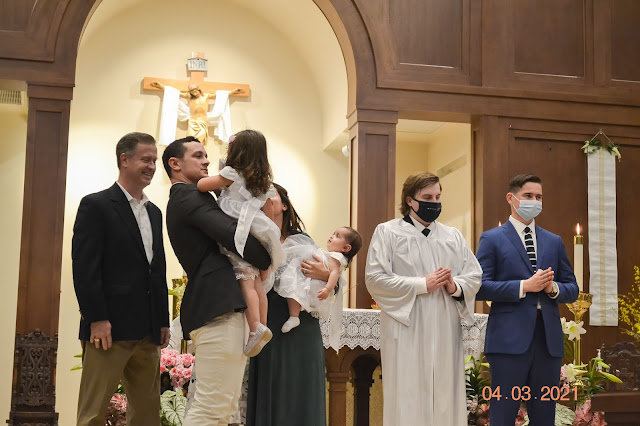We had a small class this year, in part due to the pandemic. But it was a great class. A young married couple with their two small children were received into the Church at the Easter vigil, the parents previously baptized in a Protestant Church and their two children in need of baptism; a young man who was baptized and another woman received into the Church. Thus baptism, reception into the Church, Confirmation and Holy Eucharist were celebrated.
Here is a congregational view of things:




























7 comments:
Thanks for sharing. May everyone in your parish have a Blessed Easter.
My prayers for all the new Catholics and Christians.
No offence to your church, which is immeasurably lovlier than the squat modern local horror with fluorescent backlit stained glass behind the altar and tabernacle (with dangling power cord with in-line switch to turn the window on), but, in looking at your current page header photo, was struck by how much, if crucifix and tabernacle removed, it would resemble a modern upscale florist shop. Likely all the plants and smaller flower arrangements placed just-so combined with the wood paneling and white "display cases and tables".
Anon - Well, that just goes to show you . . . The furnishings and decor don't make it a Catholic Church!
Maybe I should have said that with flowers. Also, much of the impression is from the photo perspective minimizing height of the enclosed space plus the extra furnishings scattered about, but it very much reminded me of a florist once greatly used, and just could not shake that impression when viewing that shot. Locally, no mistaking the parish church for a florist, and actually is rather hard to mistake for a church, either.
I have only attended an Easter Vigil in what is called the Ordinary Form. In some respects it is preferable to the 1955 version (in fact trialled earlier) which I would not go out of my way to attend. Yet the most solemn version of the 1970 rite, mostly in Latin with none of the optional short-cuts taken, was mind-blowing when I encountered it at the London Oratory in 1978.
Done properly, it is a very long service. If there are baptisms, these take place three-quarters of the way through it and will prolong it even further. Infant baptisms (at a time approaching midnight) are not appropriate, or to use a modern term 'pastorally insensitive'.
I suspect those who see the Easter Vigil primarily as a baptismal service use the shorter form of the Exsultet (in English), omit some of the (seven) prophecies, add at least one homily, and then get the Mass over with as soon as possible. The three-fold Alleluia (sung on a higher tone each time) will be noticeable by its absence.
The idea of singing a long setting of the Gloria (e.g. Haydn or Beethoven) which enables all the candles on all the side altars to be lit, would be anathema.
I don't know what music was sung at Fr Allan's Easter Vigil, but the photo showing someone tickling the ivories of a grand piano did not bode well.
John Nolan,
I am an accomplished pianist and despise piano music in Church. Another stupid idea from the 1970s.
Pierre,
The solemn services of the Triduum are more or less defined by their music, particularly the chant. An Easter Vigil done in English with musical settings which cannot have been composed before 1965 would to me be a travesty. The idea of eight 'Responsorial Psalms' replacing the canticles in the 1974 Graduale (and we're looking at the Novus Ordo here) would have me tearing my hair out. At solemn occasions like this we are connected with past ages. A picture dating from the tenth century shows the deacon singing the Exsultet at Monte Cassino. The idea of the same scene, with the same chant and in the same language in the 21st century is extraordinarily compelling.
On Good Friday, during the 'creeping to the cross' we hear the Improperia. They are not added-on items, but integral to the liturgy. The setting by Tomas Luis de Victoria is achingly beautiful, but not in the least elaborate, and alternates with the chant in a wonderful synthesis. Profoundly moving, especially when in the Hagios O Theos we hear both Greek and Latin.
This means nothing to those who would see the liturgy as modern Man doing something of his own devising that is relevant to himself and his (debased) cultural milieu without any diachronic element. That's the real divide, not arguments regarding OF and EF.
Sadly many of those who might appreciate something different from what is generally on offer in the vast majority of parishes are not aware of, or cannot access, anything else.
Post a Comment